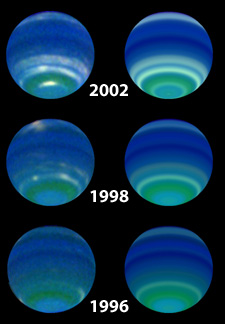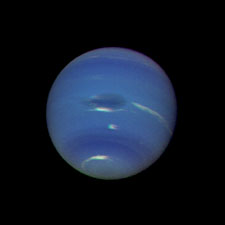
Neptune has become markedly cloudier since 1996, as these false-color images show. Individual snapshots are on the left and rotationally averaged blends on the right. To make these views, astronomers used the Hubble Space Telescope to record the planet in blue and red light, along with a near-infrared band partly absorbed by methane gas. The resulting composite emphasizes cloud features high in Neptune's atmosphere.
Courtesy Lawrence A. Sromovsky and NASA.
Astronomers have long known that Neptune's pale blue color is due to the small amount of methane gas in its atmosphere, which strongly absorbs red light. But the distant planet has undergone an unexpected color shift in recent years, becoming slightly whiter and brighter because high-altitude clouds are building at a dramatic rate.
Newly released images from the Hubble Space Telescope show that Neptune now sports a trio of patchy cloud bands in its southern hemisphere. According to Lawrence A. Sromovsky (University of Wisconsin), whose team made the observations, these bands have gotten much wider and brighter since 1996, especially at infrared wavelengths. Most likely the clouds are due to crystals of methane ice floating high in the stratosphere.
The reason for Neptune's climatic outburst remains unclear. The planet's polar axis is tipped 29° toward the Sun, which gives it a cycle of seasons much like what we experience — except that each lasts four decades. Neptune takes 165 years to complete one orbit, and right now it's nearly summer in the planet's southern hemisphere. But sunlight on Neptune has only 1/900 its intensity at Earth, Sromovsky notes, providing a "trivial amount of energy" to drive the planet's atmospheric activity.

Voyager 2 imaged Neptune's blue-hued atmosphere with unprecedented detail when it flew by in August 1989. Notice the great dark spot at center, a storm as wide as Earth.
Courtesy NASA/JPL.
Astronomers G. Wesley Lockwood (Lowell Observatory) and Donald T. Thompson began recording Neptune in blue and yellow light in 1972. They soon noticed a slight increase in brightness, which so far amounts to just 0.1 magnitude, and they suspected that the 11-year-long solar cycle was somehow responsible. One possibility was that, during lulls in solar activity, increased bombardment by galactic cosmic rays somehow triggered a burst of cloud formation. But no such long-term correlation appears to exist.
Instead, the growing HST and ground-based evidence argues that gradual heating of the upper atmosphere is somehow involved. Perhaps buoyant plumes of warm gas are bubbling up to higher, colder altitudes, causing methane to condense as ice crystals. Alternately, an unknown chemical reaction may be taking place.
During its 1989 flyby Voyager 2 noticed several bright, rapidly changing cloud patches on Neptune that seemed to be associated with dark, roundish "storms." The cloud cover has increased quite dramatically since then. Sromovsky notes that the three bands all lie in the sunny south, far from Neptune's equatorial region, centered at latitudes –30°, –45°, and –67°. This hints that some kind of seasonal change is under way.
Sromovsky's team presents its findings in the May issue of the planetary-science journal Icarus.
 0
0
Comments
You must be logged in to post a comment.